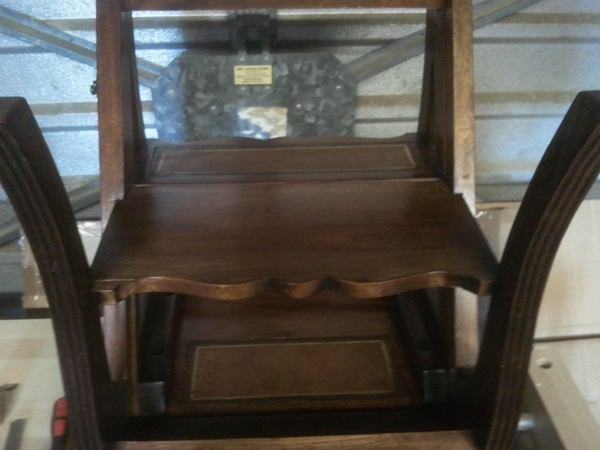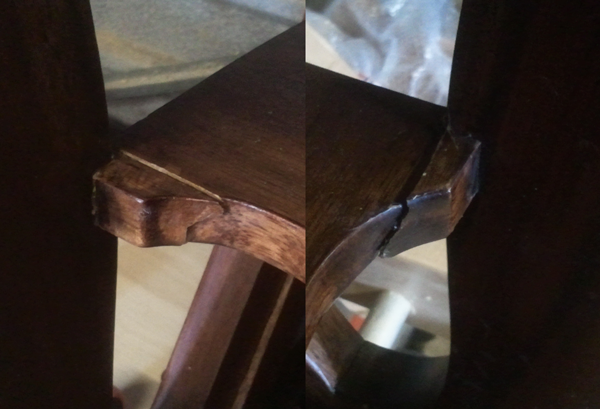I've been asked if I can try and fix this library chair that my parents own. It's one of those ones where the back folds down and it turns into a little set of steps. The bottom step on this one is held in place by four housing joints and - thanks to the arguably kind of thoughtless decorative cut on the front edge, right next to the shortest ones, it's snapped along the grain:


My first thought was to try and hold the breaks apart, apply glue to the inside, then clamp them shut and clamp blocks to the top and bottom of them to keep them in line. Which all worked spectacularly well until 24 hours later when I took the clamps off and both joints broke instantly! It seems that there's some stress in the frame somewhere that pulls these breaks out of alignment - as you can see in the second photo, without any clamps on them the joins move out of plane by about a millimetre - in different directions.
My best plan right now involves re-gluing, maybe with a gap-filling epoxy, then while it's still in clamps drill through the broken-off bits into the main board of the step and insert screws to hold it all together permanently. I'm a bit concerned that drilling through the small broken-off bits may weaken them further, but the only other thing I can think of would be to replace the entire thing and cut the decorative part less aggressively, but I have little idea how to go about disassembling it!
(I'm also concerned about being able to match the finish, but so far as I can tell it's just generic-mahogany-woodstain slopped on by the bucketload, so hopefully that won't be too problematic. I figure that if I can get it structurally sound I can just strip off the finish from the front edge of that step, glue a layer of veneer along it and then stain it to match as best as I can. There's a chip missing from the top side of one of the breaks as well, so I'll need to carve a patch to fit that and try and match the stain anyway.)
Anyone got any better ideas? Other than throwing it away and building an entire replacement chair, which I'm sure would be incredibly fun but is a little more of an investment than I was hoping to put into this one!


My first thought was to try and hold the breaks apart, apply glue to the inside, then clamp them shut and clamp blocks to the top and bottom of them to keep them in line. Which all worked spectacularly well until 24 hours later when I took the clamps off and both joints broke instantly! It seems that there's some stress in the frame somewhere that pulls these breaks out of alignment - as you can see in the second photo, without any clamps on them the joins move out of plane by about a millimetre - in different directions.
My best plan right now involves re-gluing, maybe with a gap-filling epoxy, then while it's still in clamps drill through the broken-off bits into the main board of the step and insert screws to hold it all together permanently. I'm a bit concerned that drilling through the small broken-off bits may weaken them further, but the only other thing I can think of would be to replace the entire thing and cut the decorative part less aggressively, but I have little idea how to go about disassembling it!
(I'm also concerned about being able to match the finish, but so far as I can tell it's just generic-mahogany-woodstain slopped on by the bucketload, so hopefully that won't be too problematic. I figure that if I can get it structurally sound I can just strip off the finish from the front edge of that step, glue a layer of veneer along it and then stain it to match as best as I can. There's a chip missing from the top side of one of the breaks as well, so I'll need to carve a patch to fit that and try and match the stain anyway.)
Anyone got any better ideas? Other than throwing it away and building an entire replacement chair, which I'm sure would be incredibly fun but is a little more of an investment than I was hoping to put into this one!





































